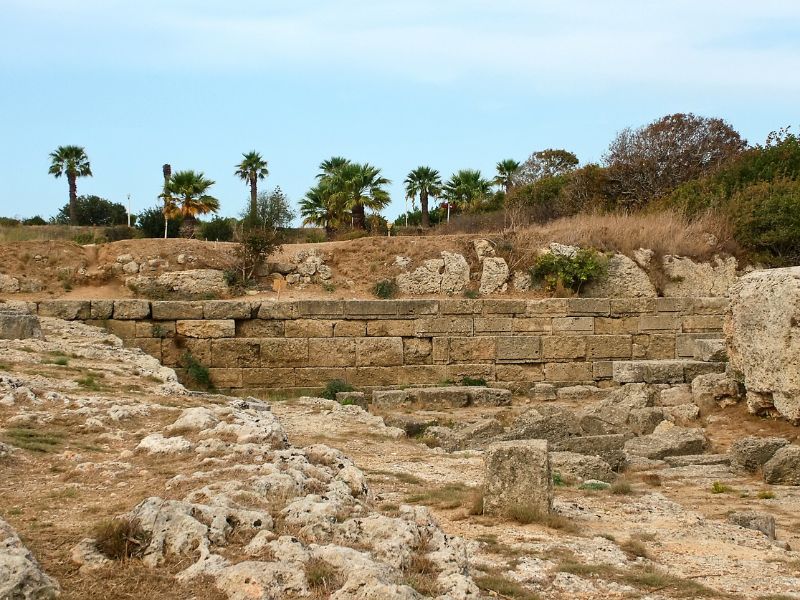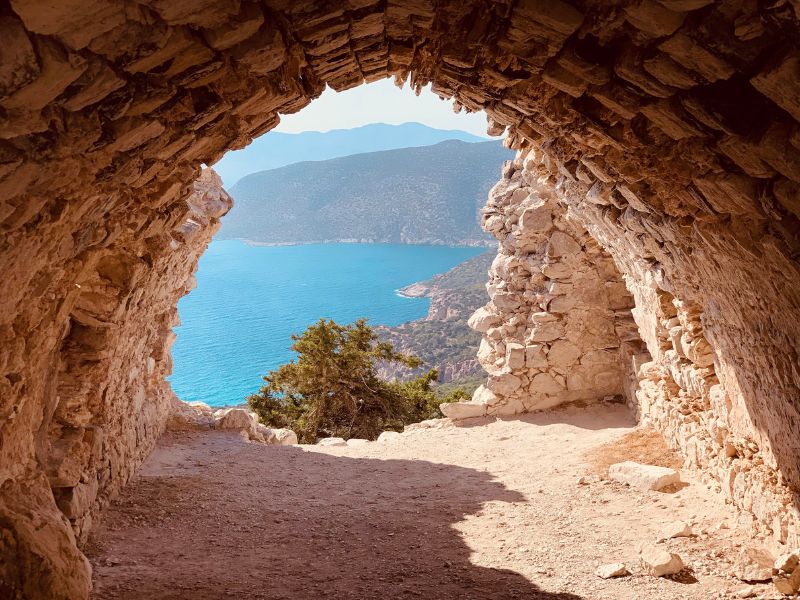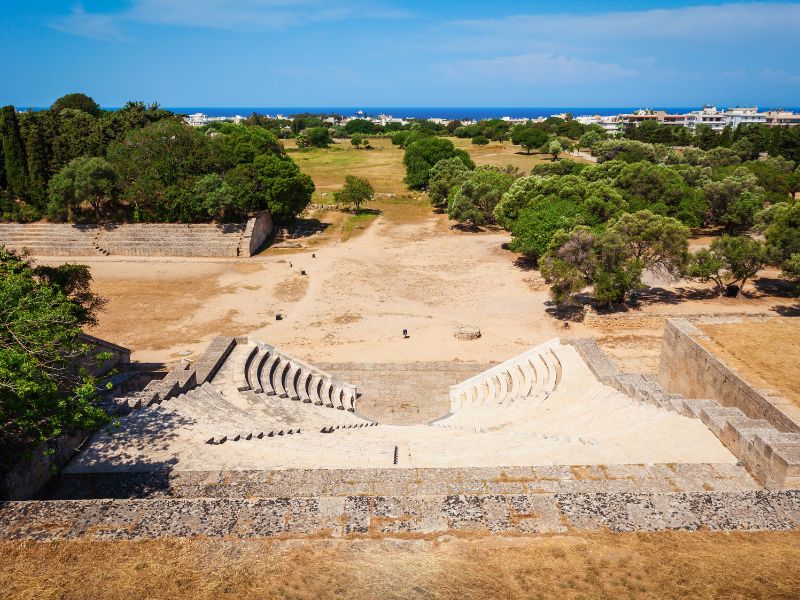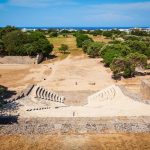
The Ancient Stadium of Rhodes: Arena of the Halieia Games
May 20, 2025
The Rhetoric Schools of Rhodes: Voices of the Ancient World
May 28, 2025Table of Contents
A Hall Where Echoes Still Breathe
Beneath the terraces of the Acropolis, the Odeon of Rhodes once shimmered with music and the measured rise of human voices. Lyres rang, poets spoke, and an audience answered with applause that seemed to join the rhythm of the sea below. It was more than a theatre — it was a shrine to harmony itself, a place where beauty, knowledge, and faith were carried on sound.
Built in the Hellenistic age, the Odeon embodied the Rhodian conviction that art was never just entertainment. Every melody and every speech were seen as acts of enlightenment, tuning the soul to divine order. Even now, when only fragments remain, one can almost hear the lingering cadence of that ideal.
The Architectural Grace of the Odeon of Rhodes

Smaller than a grand theatre yet no less refined, the Odeon of Rhodes seated perhaps eight hundred spectators. Its semicircular cavea, orchestra, and modest stage followed the classical pattern, but its roof — rare in antiquity — set it apart. It enclosed the music, holding the sound close, giving clarity and warmth that open theatres could not.
Made of bright local limestone, the interior caught and reflected the Aegean light, creating a quiet glow even indoors. Every surface was deliberate: clean, proportioned, and graceful. Positioned beside the gymnasium and the library, it completed the Acropolis’s triad of training — body, mind, and voice.
The scale was intimate; a whisper could reach the farthest row. Here, the Rhodians didn’t seek spectacle but precision — an architecture shaped to the rhythm of human thought and song.
Stage of Music and Poetry
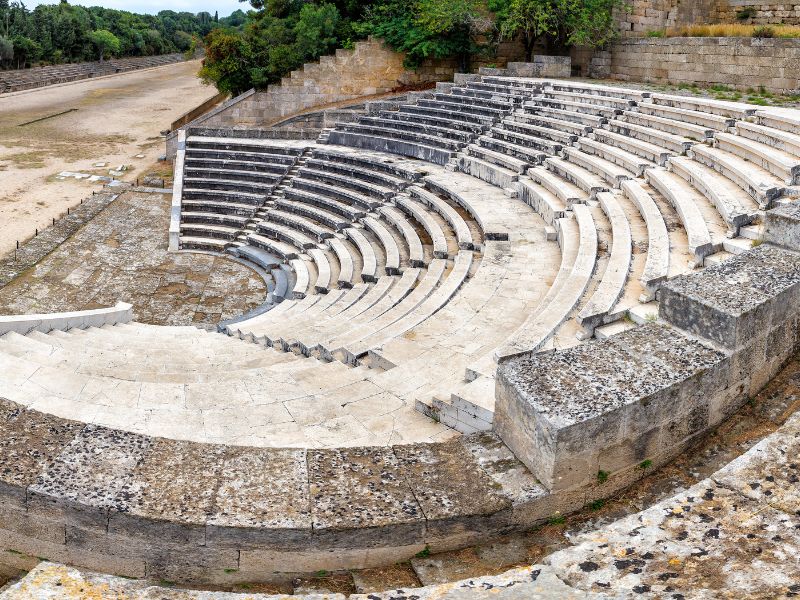
Within these walls, music was more than art — it was a sacred language. Performers tuned their lyres, flautists breathed life into the air, and poets recited verses that bound gods and mortals in one story. The hall magnified not just sound but emotion; each note seemed to travel through the audience like sunlight through water.
During festivals such as the Halieia, contests of music accompanied athletic games. The same spirit that guided the athlete’s stride inspired the singer’s breath. Apollo’s temple crowned the hill above, and his blessing, it was believed, lingered in the acoustics below.
Poets sang of Helios and civic virtue, voices echoing against marble until art became worship. To speak or sing beautifully was, for the Rhodians, to honour the gods through the discipline of sound.
The Schools of Rhetoric
Rhodes was famous across the Mediterranean for its rhetorical schools, and the Odeon of Rhodes served as both classroom and stage. Here, future diplomats and philosophers learned to shape words into instruments of persuasion. The building’s perfect acoustics trained their ears; its small audience taught them poise and restraint.
Lessons mixed rhetoric with ethics and philosophy. To argue well was to think clearly, and to think clearly was to serve the city and the divine order it reflected. Public debates and contests of speech became civic rituals — measured displays of logic and grace.
In this setting, the human voice itself was sacred. Each phrase, carefully balanced and spoken with conviction, mirrored the cosmic harmony that the Rhodians believed governed all life.
The Sound of a City’s Soul

The Odeon of Rhodes was more than an auditorium; it was the city’s conscience cast in stone. Its tiers welcomed citizens from every walk of life, gathered not for power or wealth but for the shared experience of sound. Music and rhetoric were acts of unity, affirmations that the human mind could mirror divine symmetry.
Every tone — a poet’s verse, a statesman’s argument, a hymn to Apollo — was a thread in the island’s identity. The building stood as an acoustic emblem of democracy itself: a place where the individual voice rose, joined others, and became something greater.
Even in ruins, the space still listens. One can imagine words moving effortlessly across the stone, rising into the open air and vanishing like waves returning to the sea.
The Eternal Voice of Rhodes
The Odeon of Rhodes was the acoustic heart of a city that believed truth could be heard as much as seen. Within its roofed arena, performance, education, and worship blended into one art. Every speech, every note, carried the same purpose — to bring human harmony closer to divine perfection.
Linked with the gymnasium’s strength, the library’s intellect, and the temples’ sanctity, the Odeon completed the triad of Rhodian excellence. It was a place where a melody became prayer, and where a well-spoken phrase could lift the soul toward the sun.
Today its stones remain, still holding the memory of sound — faint reverberations of an age that measured faith not by silence, but by the music of reason and light.
